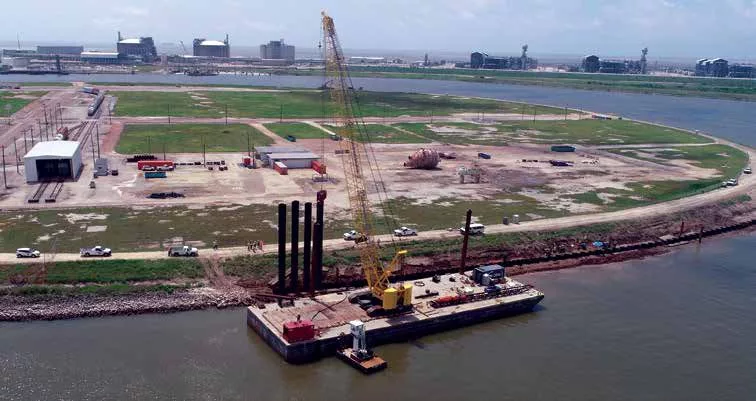The start of hurricane season was a firm deadline for a complex job — installing pile in a busy shipping channel to protect levees exposed to Gulf of Mexico storm surge.
By Warren Miller
The Freeport Harbor Channel Improvement Project is a $295-million, federal cost-shared project to enlarge and protect the channel in the harbor at Freeport, Texas, 45 miles south of Galveston.
The channel, which was deepened to its current depth of 46 feet in the early 1990s, needed to be deeper and improve its turning basins for large petroleum and LNG tankers. The improvement project will deepen the channel to 51-56 feet, making Port Freeport the deepest port in Texas and opening the state to larger ships.
Perhaps the most challenging part of the work was completed earlier this year—protecting the levees that ring the channel. Brazosport, a section of the Freeport shipping complex, is directly opposite the harbor’s channel to the Gulf of Mexico. The project called for a 3,000-linear-foot, steel combination wall (combi-wall) to protect the levee from potential hurricane washout, flooding or undermining from the dredging.

There were provisions. The combi-wall had to be in place and all water-based equipment demobilized before the start of hurricane season on June 1, 2021. Moreover, normal channel traffic—which included ships carrying petroleum, LNG, chemicals, automobiles and consumer goods—had to continue without interruption.
It wasn’t an arbitrary deadline. The risk of working over water in a tight channel in the event of a hurricane would have been severe, so finishing the job prior to hurricane exposure was a driving safety factor for everyone. Nor was impeding, let alone stopping ship traffic an option.
“In February 2020, Port Freeport received a new start designation for the commencement of construction from the U.S. Army Corps of Engineers (USACE),” the port wrote on its website. “A Project Partnership Agreement (PPA) was signed between Port Freeport and the USACE on June 25, 2020, moving the project into the construction phase. On September 14, 2020, the USACE awarded the first dredging contract to Great Lakes Dredge & Dock Company, LLC in the amount of $15.4 million. Project dredging for the first segment began in April 2021.
“The project also includes enhancements to the upper turning basin, selective widening of the channel and lower channel bend easing, making it easier for modern ships to navigate. A deeper channel will enable Port Freeport to market the Port to a wider range of global vessels, expand capacity and customer base and potentially attract new liner services. This, in turn, is expected to facilitate additional economic opportunities.”
McCarthy Building Companies was selected to install pile in and around the upper turning basin. Founded in Michigan in 1864, McCarthy is an employee-owned company with a long history of work in Texas.
The work order specified Alloy 690 (usually called A690), a steel alloy known for its high resistance to salt-water corrosion, for both the 94-foot sheet sections and the pipe pile that anchors the sheets.
“A690 is well-known in sheet pile, but typically not used in pipe pile,” said Robert Wood, the project manager for Mc- Carthy. “We sourced the pile from Turkey. Piling production was delayed because of the specs for the A690 steel, and then the Suez Canal was closed by a ship grounding. Even though that wasn’t felt directly in Freeport, there were logistical challenges from the disruption of shipping worldwide. But we overcame them.”
Another challenge was fielding two crews and two shifts per day, including a night shift, to meet the deadline. The Brazosport section of Freeport Harbor is shaped like a hand; the pile installation started at the tip of the thumb with two crews that went in opposite directions.
“We had two crews working out from the center,” Wood explained. “Quality Control had to run back and forth. And the further the crews got from each other, the more challenging that was.”

The biggest challenge, Wood explained, was how tight the channel is and how much traffic passed through the critical area where their work took place.
“It’s a choke point for the entire port,” he said. “We had our crane barges and material barges, with 94-foot pile perpendicular to the wall, and big ships coming through, RORO car-container ships, 900- foot oil tankers. We had to coordinate and work with the Brazos ship pilots and the dredgers. Contending with that, doing it safely and finishing on May 26 was an accomplishment.”
Hurricane season began, and sure enough, the combi-wall was put to a mid-level test by Nicholas, a tropical storm when it made landfall just south of Freeport in early September.
“The walls performed fine,” Wood said.














